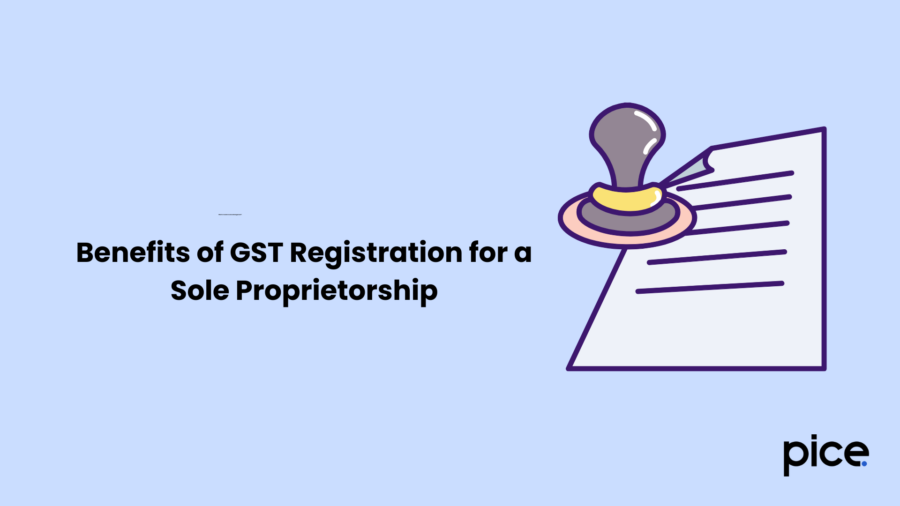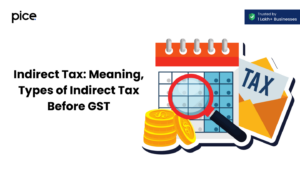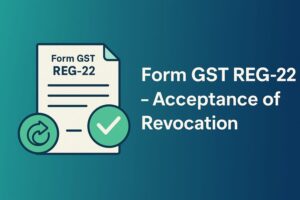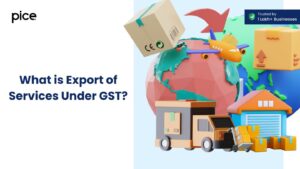GST Registration for Sole Proprietorship: A Complete Guide
- 19 May 25
- 11 mins

GST Registration for Sole Proprietorship: A Complete Guide
Key Takeaways
- GST registration is mandatory for sole proprietors exceeding turnover limits or involved in interstate/e-commerce trade.
- Voluntary registration boosts credibility and allows input tax credit claims.
- Key documents include PAN, Aadhaar, address proof, bank details, and digital signature.
- The registration process is online via the GST portal with form filling and document upload.
- Registered proprietors must file GST returns and follow tax compliance rules.
The Goods and Services Tax (GST) is a holistic indirect tax applicable to the supply of goods and services in India. Initiated on July 1, 2017, GST replaced a multitude of indirect taxes-VAT, service tax, and excise duty-and made the tax system a unified one. Any business, including sole proprietorships, above a specific turnover threshold must apply for registration under GST, for legal requirements and to escape penalties.
A sole proprietorship business is the one of the simplest form of business, owned and managed by a single individual. Since it lacks a distinct legal identity from the owner, all tax liabilities rest on the proprietor. Understanding the GST registration process, eligibility criteria, benefits, and compliance requirements is crucial for sole proprietors to ensure smooth business operations.
In this article, we shall provide a comprehensive guide to the GST registration for sole proprietorship, covering eligibility, documentation, and application procedures. An owner must understand these factors to remain compliant and run operations smoothly.
What is a Sole Proprietorship?

In India, sole proprietorship is but one of the simplest and most well-known forms of business structure. So the single owner may set up and run his business with minimum compliance requirements. Traders, freelancers, and small business owners prefer this kind of corporate structure.
Some key characteristics of a sole proprietorship are as follows:
- Single ownership: Sole proprietors are regarded as individuals who own and operate their businesses and assume full responsibility for their profits and losses.
- Easy to form: A sole proprietorship firm can be formed more easily compared with other business models, along with lesser accounting requirements and business decision to comply with.
- Tax Benefits: Tax benefits can be claimed by proprietors under the income-tax provisions for individuals; this makes it more economical than other models.
- Unlimited Liability: In contrast to the corporate structure, sole proprietors have unlimited liability. This means that the personal property of the owner can be sold off to pay the debts incurred by the business.
Sole proprietorships do give small business advantages in the area of simple operation. You should register your proprietorship after completing the MSME registration process at the earliest. Also, it would help if you understood the importance of GST in licensing your compliance with tax laws.
Who Needs to Register for GST in a Sole Proprietorship?
GST registration for a sole proprietorship is required under certain conditions in India. These conditions are primarily based on the turnover and nature of business activities. Here’s when you should consider GST registration:
1. Turnover Exceeds the Threshold Limit:
All goods-based businesses must register for GST when their annual revenue reaches or exceeds ₹40 lakh. The threshold for service-based companies to register for GST stands at ₹20 lakh.
The threshold for goods and services stands at ₹10 lakh in special category states and hilly areas.
2. E-commerce and Interstate Sales:
Your business must register for GST when selling goods or providing services that cross state borders, regardless of your annual turnover.
Sole proprietors operating in e-commerce must register for GST regardless of their sales numbers.
3. Input Tax Credit (ITC):
A sole proprietorship requires GST registration to claim input tax credit benefits for businesses that want to claim a refund of taxes paid on business-related purchases.
4. Voluntary Registration:
By voluntarily joining the GST system, your business can benefit from GST registration even if it does not reach the threshold. It will help enhance credibility and simplify transactions with other registered businesses.
When Should a Sole Proprietorship Apply for GST Registration?
A sole proprietorship must register for GST under these distinct circumstances:
1. Exceeding the Business Turnover Limit:
Your business must register for GST when its annual revenue reaches ₹40 lacks (₹20 lakh for services or ₹10 lakh in special states).
2. Engaging in Interstate Trade:
Sole proprietorship firms conducting business across state lines need to register for GST. Your business needs GST registration regardless of whether you operate in goods or service provision across different states.
3. E-commerce Operations:
Sole proprietorships conducting e-commerce activities must register for GST regardless of their turnover level. The system allows for the correct taxation of items sold through online marketplaces.
4. Claiming Input Tax Credit:
GST registration is necessary to claim input tax credit. ITC can reduce your tax burden by offsetting the GST paid on purchases against the output tax liability.
5. Voluntary Registration:
A business entity can decide to register voluntarily regardless of mandatory registration requirements. Registration streamlines business operations, leading to improved transactions and enhanced business credibility.
Benefits of GST Registration for a Sole Proprietorship

Sole proprietorship businesses that obtain GST registration gain multiple benefits which support their expansion and success:
- Legitimacy and Compliance:
A GST registration establishes your business as legally compliant with the law. The establishment of trust between customers, vendors, and government authorities emerges from GST registration.
- Input Tax Credit (ITC):
The most crucial advantage of GST registration is obtaining input tax credit benefits. Businesses can lower their tax expenses through GST by obtaining refunds for the taxes they paid on their business acquisition costs.
- Interstate Business:
GST registration makes interstate trade seamless by eliminating the need to pay multiple state taxes. The registration system enables businesses to conduct international sales operations without facing complex obstacles.
- Improved Market Reach:
Any business registered under GST can access government tenders and work with other GST-registered companies while building marketplace trust.
- Better Business Expansion:
GST registration enables businesses to find new expansion opportunities. Your operations can expand through market growth and customer base expansion, which helps you reach more customers.
Key Documents Needed for GST Registration
Sole proprietorship businesses must submit documents when they apply for GST registration. The documents serve two functions: verifying business operations and maintaining GST regulations. The necessary documents include:
- PAN Card of the Proprietor:
The business owner must present a legitimate PAN card to receive GST registration. The PAN card functions as the primary official identification document. You cannot file income tax returns if you do not have a PAN.
- Aadhaar Card:
The identity verification process requires an Aadhaar card. GST registration requires this document as mandatory identity proof to fight against fraud and verify authenticity.
- Photograph of the Proprietor:
The business owner needs to attach a passport-sized photo to their registration form.
- Proof of Business Address:
If the business operates from owned premises, the owner must submit proof of ownership through property tax receipts, electricity bills, or municipal khata.
The owner must provide rental agreement documents and evidence of landlord ownership to register a business on rented premises.
Virtual office space providers must issue consent letters, rental agreements, and proof of ownership documents.
- Bank Account Details:
Business owners need to provide their bank account information through a cancelled cheque or bank statement to establish a connection between financial transactions and GST.
- Digital Signature Certificate (DSC):
The digital signature certificate functions as an essential requirement for the digital signature of the registration application.
The Step-by-Step Guide to Register for GST as a Sole Proprietorship Business

You can start the registration process for sole proprietorship through the GST portal after obtaining all required documents. Here is a step-by-step guide:
Step 1: Access the GST Portal
You should start your registration process by accessing the official GST portal at https://www.gst.gov.in. Then, navigate to the Registration section and select "New Registration" from the portal.
Step 2: Complete Part A of the Application
In this step, you must fill out Part A of the application form (GST REG-01). Enter the following details:
- Business Name: Provide the legal name of your business.
- PAN Number: Enter the proprietor's Permanent Account Number (PAN).
- Email and Mobile Number: Use a valid email and phone number for communication and verification.
- State and District: Select the state and district in which your business is located.
Step 3: Verification Through OTP
After you submit Part A of the application, the system will send an OTP to your registered mobile number and email address. You need to use this OTP to confirm your application.
Step 4: Fill Part B of the Application
After successful verification, the application process will lead you to Part B of the application form. Here, you must provide more details about your business:
- Type of Business: Specify whether you are a goods or service provider.
- GSTIN of Authorised Signatory: If applicable, provide the GSTIN of the authorised person.
Step 5: Upload Documents
The system requires you to submit all necessary documents, including PAN and Aadhaar, address proof, and bank details, in the required file format.
Step 6: Submit the Application
When you have cross-checked all the information, you must submit the application. At this point, the system will produce a distinctive Application Reference Number (ARN). Please keep it for future reference.
Step 7: Verification and GST Registration Certificate
The GST authorities will conduct a review process of the submitted application. They may ask for additional documents or clarification if needed. Upon successful verification, you will receive your GST registration certificate.
Conclusion
GST registration is required for a sole proprietorship for developing more business compliance and to avail of all benefits under GST regime. Additionally, voluntary GST registration will elevate one's image in the market and expand opportunities even if one is not legally required to register. Once one registers a business, there will be the necessity of filing GST returns according to applicable rules and timelines.
So far as the prospect of giving GST registration for sole proprietorship is concerned, it gravitates and caters accordingly, irrespective of whether the sole proprietor affords goods or services. This blog has captured the essence of the eligibility and application process thereof.
💡If you want to streamline your invoices and make payments via credit or debit card or UPI, consider using the PICE App. Explore the PICE App today and take your business to new heights.
 By
By 

















